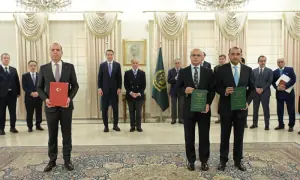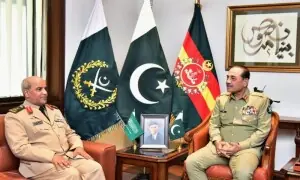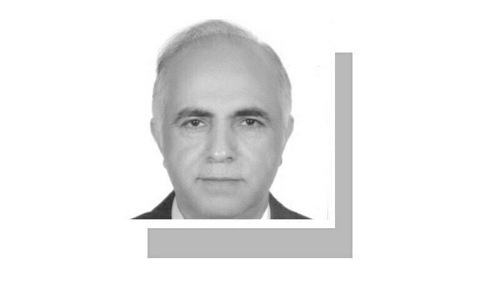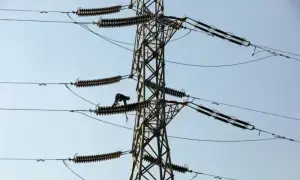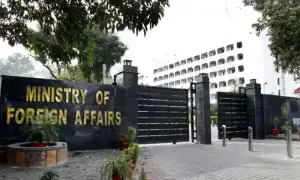
THE Long-Term Plan (LTP) document for CPEC was developed by the China Development Bank and finalised by December 2015. One year later, on December 29, 2016, it was finalised by both sides in the sixth Joint Cooperation Committee meeting held in Karachi. Minister for Planning and Development, Mr Ahsan Iqbal, is claiming that along the way significant revisions were made to the plan, to the point of rendering the original one “redundant”.
From what can be understood, since much of this has been kept secret, the revisions that have been made relate mainly to the transport plan, which was developed by the Pakistani side, and the other areas of cooperation identified in Dawn’s story were largely untouched. We will know how much changed in the plan once it is made public, which the minister has committed to doing within a month. He made the commitment on Shahzeb Khanzada’s show on the night of May 16, and must be made to stand by it.
His reaction to the story was puzzling. He said the story was written in such a way as to present CPEC as a “nightmare scenario”. Can someone point out which line in the story even suggests that the whole enterprise is bad, let alone a “nightmare scenario”.
All the story does is lay out the details contained in the LTP that was drawn up by the Chinese government. If the minister finds these details frightening, then he needs to ask himself why rather than blame the story.
Many people are in fact impressed with the scope of the plan, and although there are reservations about some of the items in it (such as visa-free entry for Chinese nationals with no reciprocal measure for Pakistanis) on the whole it could turn out to be a very favourable development for Pakistan.
In the same interview, he said that CPEC is the “most discussed and most debated project” of the country, and also the “most transparent”.
He claimed that there is no detail in it that has not been probed by committees in the Senate and National Assembly, and numerous briefings have been given in chambers, committees and other forums. He claimed all details are on their website.
We will know how much has changed in the Long-Term Plan for CPEC once it is made public.
This assertion is also puzzling. How many people have seen the LTP? We know there are some, and we also need to ask what feedback they gave and how it was received. But aside from those few, when have the elements of the LTP ever been discussed before parliament or with business leaders?
It is true that he has given numerous briefings to various forums along the way. But those have been highly selective, focusing only on those areas the government wants to draw our attention to.
For instance, take this rather strange incident that was reported in the daily Business Recorder. A seminar was under way at the International Growth Centre on CPEC. The panel consisted of Dr Safdar Suhail, then executive director of the CPEC Centre for Excellence at PIDE and the man charged with developing Pakistan’s response to the LTP. The other panelist was Miftah Ismail, chairman of the Board of Investment (BoI) and another key player in the CPEC negotiations.
Here is what the report says: “Dr Safdar Sohail … pointed out how agriculture was one of the ‘pillars’ of the CPEC.” Pillar, mind you, which refers to something being very critical. A few minutes later, an environmentalist asked Safdar’s co-panelist (sitting on the same stage), Miftah Ismail, the boss of BoI, about the environmental assessment of Chinese interest in Pakistan’s agricultural land. And his response: CPEC has nothing to do with agriculture in Pakistan.”
Throughout this time, the government put out misleading signals. In another such event, where Minister Ahsan Iqbal was briefing reporters about CPEC, in September 2016, shortly before the finalisation, he is quoted telling reporters that “CPEC has three phases and four major areas, namely Gwadar Port’s development, energy projects, road networks and industrial cooperation.” No mention of fibre optic connectivity, of agriculture or ‘tourism’.
This is a pattern that repeats itself throughout the time when the government was engaged with their Chinese counterparts on the LTP. The information that has been drip-fed to the public and stakeholders is always selective, vague, and thoroughly sanitised.
The minister has preferred to speak in large generalities, and is reluctant to discuss details. The net result is that people are genuinely surprised to learn that there is a lot more to CPEC than what they imagined, which is roads, power plants and Gwadar.
Here is what is going on: the Chinese have drawn up the LTP which details what they want. The Pakistanis have drawn up their list of power plants and the monographic study on transport, which details what they want. The Chinese want access to our agrarian economy and our domestic market, amongst a few other things. In the shorter version of the LTP, circulated to the provincial governments in February this year, there is a list of key “areas of cooperation”.
There are seven areas listed: connectivity (roads and fibre optic), energy, industry, agriculture (to include “modern agriculture demonstration zones”), tourism (with two centres in Gwadar and Karachi, and five zones from Keti Bander to Jiwani), livelihoods, and finance.
The section on livelihoods appears to be designed specifically to bring “construction of public transport system” into the CPEC ambit. The emphasis on roads, energy and livelihoods appears to have come from the Pakistani side. The emphasis on industry, agriculture, tourism and finance has come from the Chinese side. These are the same areas the details of which are given in my report. So what has changed in those details?
Let me emphasise that nothing said here is to suggest in any way that CPEC is a bad thing. I do not believe that. But people have a right to know what exactly is being agreed to under its ambit.
The writer is a member of staff.
Twitter: @khurramhusain
Published in Dawn, May 18th, 2017






